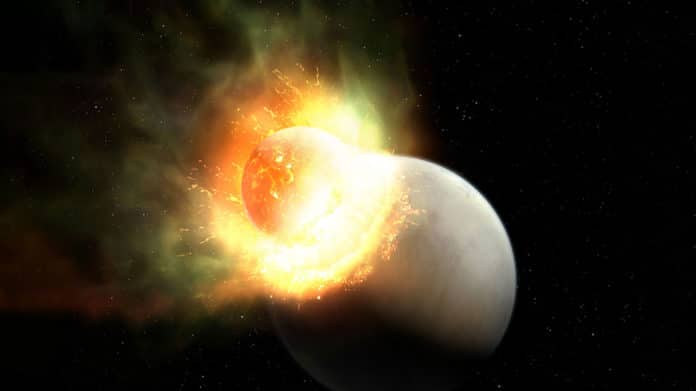Young planets sometimes experience giant impacts. Even in our solar system, the Earth and moon are thought to be products of this type of giant impact.
Such impacts have been challenging to observe around other stars.
Now, astronomers offered evidence of such a giant impact in a nearby star system, just 95 light-years from Earth. The collision is likely to occur between an alien planet- an Earth-sized planet and a smaller impactor.
The team speculated that the impact occured about 200,000 years ago, at speeds of 10 kilometers per second, or more than 22,000 miles per hour. Notably, the impact fades away the part of the larger planet’s atmosphere.
The team includes astronomers from MIT, the National University of Ireland Galway, Cambridge University, and elsewhere. The event occured near the star HD 172555 that is located about 23 million years old.
Astronomers detected the evidence of the event in the observed gas and dust around the star.
Lead author Tajana Schneiderman, a graduate student in MIT’s Department of Earth, Atmospheric and Planetary Sciences, said, “This is the first time we’ve detected this phenomenon, of a stripped protoplanetary atmosphere in a giant impact. Everyone is interested in observing a giant impact because we expect them to be common, but we don’t have evidence in many systems for it. Now we have additional insight into these dynamics.”
The star HD 172555 consists of dust with unique composition, containing large amounts of unusual minerals in grains that are much finer than typical stellar debris disk.
Lead author Tajana Schneiderman, a graduate student in MIT’s Department of Earth, Atmospheric and Planetary Sciences, said, “Because of these two factors, HD 172555 has been thought to be this weird system.”
The team wondered what the gas might reveal about the system’s impact history. To observe, they gathered the data from ALMA. They looked for carbon monoxide around HD 172555.
With careful reanalysis, they detected carbon monoxide around the star. They also observed that the gas circled in large amounts, surprisingly close to the star, at about ten astronomical units.
Schneiderman said, “The presence of carbon monoxide this close requires some explanation.”
One possible scenario includes the emergence of gas from the debris of a newly formed star and one in which a close-in belt of icy asteroids produced the gas. Another scenario consists of the gas was emitted by many icy comets streaking in from a far-out asteroid belt, similar to our Kuiper belt. But the data didn’t quite fit this scenario either. The last scenario the team considered was that the gas was a remnant of a giant impact.
Schneiderman said, “Of all the scenarios, it’s the only one that can explain all the features of the data. In systems of this age, we expect there to be giant impacts, and we expect giant impacts to be quite common. The timescales work out, the age works out, and the morphological and compositional constraints work out. The only plausible process that could produce carbon monoxide in this system in this context is a giant impact.”
Based on gas’ abundance, it is speculated that impact was likely massive enough to blow off one planet’s atmosphere.
Schneiderman said, “Now there’s a possibility for future work beyond this system. We are showing that if you find carbon monoxide in a place and morphology consistent with a giant impact, it provides a new avenue for looking for giant impacts and understanding how debris behaves in the aftermath.”
Hilke Schlichting, professor in Earth, planetary, and space sciences at the University of California at Los Angeles, who was not involved in the research, said, “What is particularly exciting about this work, in my opinion, is that it demonstrates the importance of atmospheric loss by giant impacts. It also opens up the possibility to study the composition of the atmospheres of extrasolar planets undergoing giant impacts, which ultimately may help shed light on the atmospheric condition of the terrestrial planets during their giant impact stage.”
Journal Reference:
- Schneiderman, T., Matrà, L., Jackson, A.P. et al. Carbon monoxide gas produced by a giant impact in the inner region of a young system. Nature 598, 425–428 (2021). DOI: 10.1038/s41586-021-03872-x
